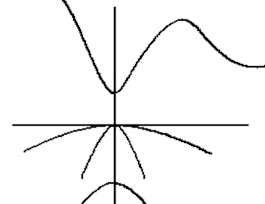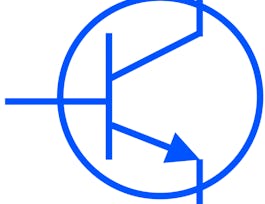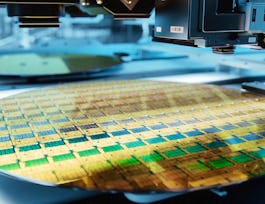This course can also be taken for academic credit as ECEA 5630, part of CU Boulder’s Master of Science in Electrical Engineering degree.


Semiconductor Physics
This course is part of Semiconductor Devices Specialization
Taught in English
Some content may not be translated

Instructor: Wounjhang Park
28,939 already enrolled
Included with 
Course
(254 reviews)
90%
What you'll learn
Understand the energy band structures and their significance in electric properties of solids
Analyze the carrier statistics in semiconductors
Analyze the carrier dynamics and the resulting conduction properties of semiconductors
Details to know

Add to your LinkedIn profile
4 quizzes
Course
(254 reviews)
90%
See how employees at top companies are mastering in-demand skills

Build your subject-matter expertise
- Learn new concepts from industry experts
- Gain a foundational understanding of a subject or tool
- Develop job-relevant skills with hands-on projects
- Earn a shareable career certificate


Earn a career certificate
Add this credential to your LinkedIn profile, resume, or CV
Share it on social media and in your performance review

There are 4 modules in this course
In this module we will introduce the course and the Semiconductor Devices specialization. In addition, we will review the following topics: Type of solids, Bravais lattices, Lattice with basis, Point defects, Dislocation, Bulk crystal growth, Epitaxy, Energy levels of atoms and molecules, Energy bands of solids, Energy bands in real space, Energy bands in reciprocal lattice, Energy band structures of metal and insulator, Definition of semiconductor, Electrons and holes, and Effective mass.
What's included
9 videos3 readings1 quiz1 peer review2 discussion prompts
In this module, we will cover carrier statistics. Topics include: Currents in semiconductors, Density of states, Fermi-Dirac probability function, Equilibrium carrier concentrations, Non-degenerate semiconductors, Intrinsic carrier concentration, Intrinsic Fermi level, Donor and acceptor impurities, Impurity energy levels, Carrier concentration in extrinsic semiconductor, and Fermi level of extrinsic semiconductors.
What's included
5 videos2 readings1 quiz1 peer review1 discussion prompt
This module introduces you to currents in semiconductors. Topics we will cover include: Thermal motion of carriers, Carrier motion under electric field, Drift current, Mobility and conductivity, Velocity saturation, Diffusion of carriers, General expression for currents in semiconductor, Carrier concentration and mobility, and the Van der Pauw technique.
What's included
4 videos2 readings1 quiz1 discussion prompt
In this module we explore carrier dynamics. Topics include: Electronic transitions in semiconductor, Radiative transition, Direct and indirect bandgap semiconductors, Roosbroeck-Shockley relationship, Radiative transition rate at non-equilibrium, Minority carrier lifetime, Localized states, Recombination center and trap, Shockley-Hall-Reed recombination, Surface recombination, Auger recombination, Derivation of continuity equation, Non-equilibrium carrier concentration, Quasi-Fermi level, Current and quasi-Fermi level, Non-uniform doping, and Non-uniform bandgap.
What's included
8 videos2 readings1 quiz1 peer review
Instructor

Offered by
Recommended if you're interested in Electrical Engineering

University of Colorado Boulder

University of Colorado Boulder

University of Colorado Boulder

Arizona State University
Get a head start on your degree
This course is part of the following degree programs offered by University of Colorado Boulder. If you are admitted and enroll, your coursework can count toward your degree learning and your progress can transfer with you.
Why people choose Coursera for their career




Learner reviews
Showing 3 of 254
254 reviews
- 5 stars
66.27%
- 4 stars
20.78%
- 3 stars
6.27%
- 2 stars
1.96%
- 1 star
4.70%

Open new doors with Coursera Plus
Unlimited access to 7,000+ world-class courses, hands-on projects, and job-ready certificate programs - all included in your subscription
Advance your career with an online degree
Earn a degree from world-class universities - 100% online
Join over 3,400 global companies that choose Coursera for Business
Upskill your employees to excel in the digital economy
Frequently asked questions
Access to lectures and assignments depends on your type of enrollment. If you take a course in audit mode, you will be able to see most course materials for free. To access graded assignments and to earn a Certificate, you will need to purchase the Certificate experience, during or after your audit. If you don't see the audit option:
The course may not offer an audit option. You can try a Free Trial instead, or apply for Financial Aid.
The course may offer 'Full Course, No Certificate' instead. This option lets you see all course materials, submit required assessments, and get a final grade. This also means that you will not be able to purchase a Certificate experience.
When you enroll in the course, you get access to all of the courses in the Specialization, and you earn a certificate when you complete the work. Your electronic Certificate will be added to your Accomplishments page - from there, you can print your Certificate or add it to your LinkedIn profile. If you only want to read and view the course content, you can audit the course for free.
If you subscribed, you get a 7-day free trial during which you can cancel at no penalty. After that, we don’t give refunds, but you can cancel your subscription at any time. See our full refund policy.

